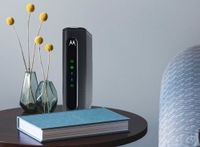Cellphone Radiation: The WHO's take on things

We mentioned earlier that the LG Breakthrough ranked the best with respect to the smartphones with the lowest radiations emissions. On the heels of that study, we've learned the WHO has chimed in on the issue of whether or not prison cell phone radiation is dangerous or non. No, not the rock group the Who but the World Wellness Organization.
In a joint press released issued today with the International Agency for Inquiry on Cancer, the WHO classifies radio frequency electromagnetic fields as possibly carcinogenic to humans. This tags the electromagnetic fields as a Group 2B carcinogen that also includes lead, Ddt pesticides, and chloroform. They base this possibility on an increased risk for glioma, a cancerous type of brain cancer associated with wireless telephone utilise.
A more extensive study on the assessment by the WHO volition exist published in the July outcome of The Lancet Oncology, but commenting on the findings, Dr. Jonathan Samet, chairman of the working group for this studying, states,:
"The conclusion ways that there could be some risk, and therefore we need to keep a close lookout for a link between cell phones and cancer risk."
Additionally, the Director of the IARC, Christopher Wild, commented:
"it is of import that additional inquiry exist conducted into the long-term, heavy employ of mobile phones. Pending the availability of such information, it is important to have pragmatic measures to reduce exposure such every bit hands?free devices or texting."
It is nice that there isn't a blitz to judgement on this issue (keeping things termed equally "potential" or "possible" take chances) and that it is recognized that additional research is needed to determine what connection exists betwixt serious health issues and cell phone use.
Again, by no means are nosotros suggesting you should stop using your Windows Telephone. But information technology never hurts to be informed on the equipment we use. After the break yous can catch the full press release from the WHO.
Source: IARC Via:CNN
IARC CLASSIFIES RADIOFREQUENCY ELECTROMAGNETIC FIELDS Equally Mayhap CARCINOGENIC TO HUMANS
Lyon, French republic, May 31, 2022 ‐‐ The WHO/International Agency for Research on Cancer (IARC) has classified radio frequency electromagnetic fields as possibly carcinogenic to humans (Group 2B), based on an increased take chances for glioma, a malignant blazon of brain cancer (one), associated with wireless phone use.
Background
Over the final few years, there has been mounting concern near the possibility of adverse wellness effects resulting from exposure to radiofrequency electromagnetic fields, such as those emitted past wireless communication devices. The number of mobile telephone subscriptions is estimated at v billion globally.
From May 24–31 2022, a Working Group of 31 scientists from 14 countries has been meeting at IARC in Lyon, France, to appraise the potential carcinogenic hazards from exposure to radiofrequency electromagnetic fields. These assessments will be published equally Volume 102 of the IARC Monographs, which will exist the fifth volume in this series to focus on physical agents, after Volume 55 (Solar Radiation), Book 75 and Volume 78 on ionizing radiation (X‐rays, gamma‐rays, neutrons, radio‐nuclides), and Volume 80 on non‐ionizing radiation (extremely low‐frequency electromagnetic fields).
The IARC Monograph Working Grouping discussed the possibility that these exposures might induce long‐term health furnishings, in item an increased run a risk for cancer. This has relevance for public wellness, specially for users of mobile phones, every bit the number of users is large and growing, particularly among young adults and children.
The IARC Monograph Working Group discussed and evaluated the available literature on the following exposure categories involving radiofrequency electromagnetic fields:
occupational exposures to radar and to microwaves;
environmental exposures associated with transmission of signals for radio, television and
wireless telecommunication; and
personal exposures associated with the utilise of wireless telephones.
International experts shared the circuitous job of tackling the exposure data, the studies ofcancer in humans, the studies of cancer in experimental animals, and the mechanistic and other relevant data.
Results
The show was reviewed critically, and overall evaluated as existence express (2) among users of wireless telephones for glioma and acoustic neuroma, and inadequate (3)to depict conclusions for other types of cancers. The evidence from the occupational and environmental exposures mentioned above was similarly judged inadequate. The Working Group did non quantitate the adventure; however, one report of past cell phone use (upward to the year 2004), showed a 40% increased risk for gliomas in the highest category of heavy users (reported average: xxx minutes per twenty-four hour period over a 10‐year catamenia).
Conclusions
Dr Jonathan Samet (University of Southern California, United states of america), overall Chairman of the Working Group, indicated that "the evidence, while still accumulating, is stiff enough to support a conclusion and the 2B classification. The determination ways that there could be some risk, and therefore we need to keep a shut watch for a link between cell phones and cancer risk."
"Given the potential consequences for public health of this nomenclature and findings," said IARC Managing director Christopher Wild, "information technology is of import that additional inquiry be conducted into the long‐term, heavy use of mobile phones. Pending the availability of such information, it is of import to take pragmatic measures to reduce exposure such every bit hands‐free devices or texting."
The Working Group considered hundreds of scientific manufactures; the consummate listing will exist published in the Monograph. Information technology is noteworthy to mention that several recent in‐press scientific articles(4)resulting from the Interphone study were made bachelor to the working group shortly before it was due to convene, reflecting their acceptance for publication at that fourth dimension, and were included in the evaluation.
A concise report summarizing the main conclusions of the IARC Working Group and the evaluations of the carcinogenic hazard from radiofrequency electromagnetic fields (including the use of mobile telephones) volition be published in The Lancet Oncology in its July 1 event, and in a few days online.
(1) 237 913 new cases of encephalon cancers (all types combined) occurred effectually the world in 2008 (gliomas represent 2/3 of these). Source: Globocan 2008
(ii) 'Limited bear witness of carcinogenicity': A positive clan has been observed betwixt exposure to the agent and cancer for which a causal interpretation is considered by the Working Group to exist credible, only run a risk, bias or confounding could non be ruled out with reasonable conviction.
(iii) 'Inadequate testify of carcinogenicity': The available studies are of insufficient quality, consistency or statistical power to let a conclusion regarding the presence or absence of a causal clan betwixt exposure and cancer, or no data on cancer in humans are bachelor.
(4) a. 'Acoustic neuroma risk in relation to mobile telephone use: results of the INTERPHONE international case‐control study' (the Interphone Study Group, in Cancer Epidemiology, in printing)
b. 'Estimation of RF energy captivated in the encephalon from mobile phones in the Interphone study' (Cardis et al., Occupational and Environmental Medicine, in press)
c. 'Risk of brain tumours in relation to estimated RF dose from mobile phones – results from v Interphone countries' (Cardis et al., Occupational and Environmental Medicine, in printing)
d. 'Location of Gliomas in Relation to Mobile Phone Employ: A Case‐Case and Instance‐Specular Assay' (American Journal of Epidemiology, May 24, 2022. [Epub alee of print]

The best graphic symbol setups
Here are the all-time Lost Ark builds for PvE and PvP
Putting together a proficient build in Lost Ark is ane of the best ways to meliorate how effective y'all are in combat. Here's a breakdown of each of the top PvE and PvP builds in the game.

Xfinity and across
Enjoy Xfinity broadband without hardware rental fees
Xfinity cable broadband is super fast, but the $fourteen monthly fee for renting their router is steep. These combination modem routers are compatible with Xfinity cyberspace and volition save yous money in the long run.
Source: https://www.windowscentral.com/cellphone-radiation-whos-take-things
Posted by: hortonsomint1948.blogspot.com


0 Response to "Cellphone Radiation: The WHO's take on things"
Post a Comment